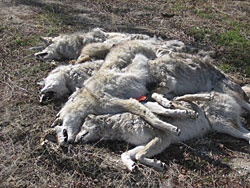

In 2003 Dennis Slaugh was exploring the wild lands near his home in Northeastern Utah when he stopped to examine a possible surveyor's marker embedded in the ground. However, it wasn't a surveyor's marker; it was a spring loaded M-44 "coyote getter" designed to explode in the mouth of a curious coyote that tugged on baited meat.
As Slaugh dusted off the metal knob, it exploded in his face spraying him with sodium cyanide. Slaugh was hospitalized and forced to retire early from his job as a heavy equipment operator, but he survived.
Today, Slaugh still has trouble breathing and suffers constant nausea and weakness- all symptoms of sodium cyanide poisoning. As terrible as his encounter was, he was lucky to have run into sodium cyanide rather than Compound 1080.
Compound 1080 (sodium fluoroacetate) is a highly toxic, slow-acting, odorless, colorless, tasteless poison with no antidote. It is so deadly that just one teaspoon is toxic enough to kill 100 human adults. Used in rubber bladders tied around the necks of sheep and goats, the "livestock protection collars" (LPCs) are meant to poison attacking predators.
However, the pouches are just as easily punctured by vegetation and barbed wire, leaking Compound 1080 into the environment where grazing animals can be poisoned from eating the contaminated forage.
And what is the fate of the predators who do attack and pierce the poison-filled collars? They suffer a prolonged and painful death, sometimes running and convulsing up to ten hours before they die. Only 10% of the bodies of poisoned animals are recovered, which leaves 90% to enter the ecosystem as food for exploring badgers, bobcats, crows, bears and pets. Scavenging leads to the secondary poisoning of thousands of innocent companion animals and unoffending wildlife, including threatened and endangered species, each year.
The poisoning of our wildlife is subsidized by U.S. tax dollars through the U.S. Department of Agriculture's Wildlife Services program. Over 120,000 native carnivores - including coyotes, wolves, bobcats, badgers, foxes, and bears - are killed every year by Wildlife Services, largely at the behest of corporate agribusiness interests. More than 13,000 of these animals are killed by poisoning with Compound 1080 and M-44 sodium cyanide devices.
In addition to poisons, snares, leghold traps, toxic gas, and aerial gunning are used by Wildlife Services against our native carnivores. Poisons are the most environmentally reckless weapon, killing indiscriminately while contaminating our environment. And we can stop this cruel and unnecessary federally supported practice by asking our Representatives to support H.R.-5643 - the Compound 1080 and Sodium Cyanide Elimination Act.
We know after two centuries of killing coyotes by our Federal Government that indiscriminate lethal control is not effective in reducing coyote populations or in protecting livestock. As Dennis Slaugh remarked in the aftermath of his near-death experience with sodium cyanide,
It is like loading a pistol, leaving it out and hoping that the bad guy comes by and shoots himself.
Poison does not always target offending predators, but there are a host of non-lethal animal husbandry practices that do protect livestock. Effective practices include confining livestock at night, using shepherds to monitor stock on the range, employing guard animals (dogs, llamas, donkeys), and using electric fencing. When these deterrents are used alone or in combination they can significantly reduce, if not eliminate, livestock losses.
But there are other reasons to urge Congress to eliminate the use of these poisons: Consider that Compound 1080 is so pernicious that the FBI notes it is "a highly toxic pesticide judged most likely to be used by terrorists or for malicious intent." Saddam Hussein stockpiled Compound 1080 as a weapon of mass destruction, and the Department of Homeland Security considers the compound a "terrorist threat." Reports from the Office of the Inspector General show that Wildlife Services failed four recent annual audits, noting that,
There is an alarming lack of inventory control and unrestricted access to poisons by unauthorized people.
It is time to urge Congress to protect our wildlife, our pets, our land, and ourselves. Please contact your Representative and urge him or her to support and co-sponsor H.R. 5643 ~ the Compound 1080 and Sodium Cyanide Elimination Act. Please take action now!
For More Information:
Open Congress Bill Tracking Website (View Bill, Track Movement, see List of Bill Co-Sponsors)